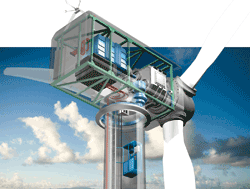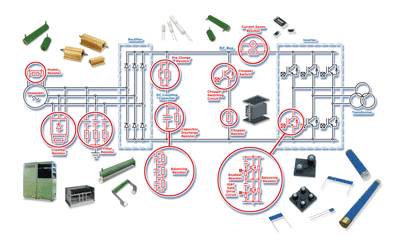Picking the right class of resistor for the task
This illustrative case study reviews the selection of power resistors in tower-mounted wind turbine systems
BY JONATHAN CATCHPOLE
Tyco Electronics, Communications and Industrial Solutions Group
Swindon, UK
http://www.tycoelectronics.com?s_cid=2188
Resistors the most basic of passive components are a ubiquitous feature of every electronic system. Yet this simplest-to-describe electrical component is available in a diverse array of types and mechanical configurations. The application is often the determining factor in defining the resistor type and package. This article will use the wind power turbine application as a means of discussing the selection and use of power resistors.
Wind turbine power resistor requirements
Wind turbines are a prime example of a complete power conversion system that combines adjustable speed drives, rectifiers, inverters and intricate control systems. These large, tower-mounted systems can generate upwards of 6 MW and the largest have rotor diameters of 80 meters and more. These systems present many unique design challenges due to location of installation (remote or off shore, off-grid, mountain top to desert) plus severe and variable environmental conditions (high and low temperature, humidity, rain, snow, dust, salt water, etc.).
Advances in wind turbine design call for innovative application of resistive elements, particularly in specialized packaging and integrated solutions. This case study is illustrative of the selection process for other industrial applications as well.
Resistor types
This application calls into play a range of requirements for power resistors of nearly all classes: wire-wound, thick film, thin film, foil, metal plate, carbon composition and ceramic.
Wire-wound . Common power resistors consisting of resistance wire wrapped around a ceramic core. Wire-wounds are robust in construction, inexpensive and have a relatively high element mass. Coupled with a wide resistance range, they provide excellent value due to their ability to withstand high currents and absorb large energy pulses. They are best suited for applications where high short term overload capacity or very high power rating is required.Thick film . Thick-film resistive elements consist of metal and glass films printed onto a flat or tubular ceramic surface. Thick film resistors demonstrate very low inductance values. They can be manufactured over a wide resistance range, from mΩ to GΩ, and then trimmed to a high degree of accuracy. Thick film devices have a higher thermal efficiency and thus higher power density than conventional wire-wound components.Thin film. Thin-film resistors are fabricated by sputtering a metal alloy onto a ceramic surface. Thin film components are typically produced with precise resistance values and are well suited to tight-specification applications.Foil/metal plate. Foil resistance elements are formed by etching or punching a metal alloy into a serpentine form which is then enclosed in a resistor package. Foil resistors possess high element mass enabling them to withstand high energy pulses while offering good thermal efficiency and low inductance. Foil elements offer a robust solution but are limited in resistance value.
Wind turbine topology

Fig. 1. A tower-mounted wind turbine integrates positioning and blade-pitch controls with a power conversion system.
The tower-mounted wind turbine depicted in Fig. 1 has three main systems:
1. Power conversion.
2. Blade pitch control.
3. Nacelle position control.
Most advance-technology wind turbines employ a dual-conversion (ac/dc – dc/ac) system to generate a tightly controlled voltage level and frequency as well as a noise and harmonic-free voltage suitable for connection to the utility grid. Blade pitch and nacelle control typically employ electric motor drives.
Wind turbine power conversion system
The power conversion system is essentially an electric motor drive operating in reverse. Figure 2 points out a number of critical power resistor applications as described below:

Fig. 2. The power conversion system in a typical wind turbine resembles a conventional variable frequency motor drive that is operated in reverse. Crowbar resistors that are engaged under fault conditions to collapse either the C bus or the Ac line voltage to ground potential so that a circuit breaker can open to safely disconnect the turbine from the grid. Resistors used for this purpose must exhibit high insulation resistance and the capability of handling very large short-term overloads.Filter resistors used on low- and high-pass filters with constant power dissipation performance characteristics combined with capacitors to limit transients commonly found in the generator output.Balancing resistors are used to divide voltages so that switching components connected in series are subjected to equal voltages during operation. These resistors must have the unique combined qualities of tight tolerance, high stability and high ohmic value.Pre-charge resistors that handle short-term overload conditions as they serve to limit inrush current on start up.Low-inductance snubber resistors that absorb repetitive high-voltage transients induced by solid-state power switching.Filter capacitor discharge resistors capable of high steady-state power dissipation to safely remove the charge when shut down.DC coupling capacitor discharge resistors with very high resistance value to dissipate high steady-state power to safely remove charge when shut down.Heater resistors are strategically placed to control the generator temperature. This is particularly important during idle time in cold climates, where wide temperature variations are likely as well as in locations where evening temperature drops and increase in dew point may result in condensation.
Resistor selection criteria
In the previous paragraphs, the specific functions for resistors in wind turbine systems have been identified. Selecting the appropriate resistor or resistor assembly for each function is based on several factors.
Physical size . As noted above, the requirement to accommodate the mechanical constraints of each application will often determine the size and placement of components. In some cases, a more expensive but more compact component will be necessary. In other cases, the modification of the standard package is all that is required to optimize component placement.Energy capacity. Some applications, like braking and snubbing, require high energy absorbing performance. Specialty capacitors such as metal plate assemblies or integrated systems will often be indicated in these applications.Insulation resistance (dielectric strength) . In higher-voltage applications or where high transient voltages are likely, it is often important to assure that the selected components have high insulation resistance and the complementary high dielectric strength.
Other commonly understood factors must also be taken into account based upon the application, including power rating and thermal de-rating, capacitance, inductance.
Suitable applications by resistor type
Table 1 summarizes the indicated uses for the different classes of resistors by application. Within a specific class, unique attributes (power rating, thermal derating, physical size, etc.) will narrow down the selection to specific product models.

Table 1. Suitable applications for resistor classification
Special packaging requirements and solutions
In the wind power application discussed in this paper as well as many other industrial applications, unique requirements call for special packaging. Special packaging may require something as simple as custom mounting or terminations, or as intricate as special housings and cooling systems from heat sinks to liquid cooling. In addition, custom resistor assemblies are often indicated to increase the power rating and/or reduce space requirements. ■
| Wire-Wound | Thick Film | Thin Film | Foil / Metal Plate | Composition | |
| Braking | * | * | |||
| Crowbar | * | * | |||
| Pre-Charge | * | ||||
| Cap. Discharge | * | ||||
| Heating | * | ||||
| Balancing | * | ||||
| Snubbing | * | * | |||
Advertisement
Learn more about TE Connectivity





